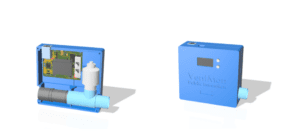Introduction
This is the final report for grant: #MOSS-2004-07366 to Public Invention from the Mozilla Open Source Software Foundation. Although the grant seems to be closed, based perhaps on our interim report, a final report is worthwhile.
Executive Summary
In fulfillment of the grant, we spent almost all ($19,795.40) of the $20,000 by Jan. 11th, 2021. We shipped more than 20 VentMons to worthy teams that signed an MOU saying they were developing open-source licensed pandemic response ventilators. The direct material costs were approximately $550 per unit, with additional expenses for tooling and shipping.
This program was a partial success. Two teams told us the VentMon was extraordinarily valuable to them (ARMEE and PolyVent), and several teams (DIY Beatmungeserat) used it.
“Watching so many teams start working on ventilator designs, Robert Read and the Public Invention team have decided that the best way they can contribute is to make an in-line monitoring device. This would be a tube that connected near the patient and would track the flow and pressure of gases as they entered and left the patient. Much of the rest of the document discusses flow and pressure sensing, but it worth noting that such a simple device like this is extraordinarily valuable and most definitely life-saving.” — Erich Schulz, MD
“The VentMon allowed us to get from thinking ‘this seems to be working’ to ‘this is really working.’ It’s an amazing piece of work and was fundamental to the development of our vent.” — Artemio Mendoza, ARMEE
“The VentMon came at an important time for our team, as Public Invention correctly identified and addressed a crucial bottleneck for the whole Open Source Ventilator movement. Their sensor pack greatly sped up prototype development and gave us a viable sensor option to pair with our device in production.” — Warren Koch, ARMEE team.
Here is a picture of the VentMon being used by the ARMEE team with a test lung taken from their YouTube Video. The VentMon is the device with the glowing green lights in the clear box on the left side, producing the waveforms shown on the computer.
The PolyVent team used the VentMon in a demo to the Mayor of Linz Austria.
Some teams (DIY Beatmungeserat, at least) made modifications to our open design. The ARMEE team split in two, and one team made this video that shows (but does not mention) the VentMon. Two teams may have built their own versions based on our plans. One engineer in Brazil reported they used it to test broken hospital ventilators. However, many teams shelved it and did not use it. This was not, apparently, because of any limitation in the VentMon, but because of a slowdown in need as the demand for emergency ventilators decreased through the pandemic.
With that said, we are planning to build 15 more VentMons with a separate grant from Protocol Labs. We augmented the design we previously shipped and have continued to improve the firmware. We will have 15 new VentMons by the end of February, which we will similarly provide free of charge to teams vetted to ensure they will use them.
A technical paper describing the VentMon has been submitted to the peer-reviewed academic journal HardwareX, and is currently being reviewed.
Additional Impact
The VentMon may have helped draw together the humanitarian engineering community in a small way by fostering cooperation. Because it supported remote (or telepresence) data display, it allowed teams to cooperate even in lockdown. It was an example of open-source enabled engineering cooperation across multiple teams. The VentMon may have assisted in getting 115, 50, and 66 (respectively) people from the entire humanitarian engineering community to come to three conferences (Vent-Con, VentCon-QA, and the PubInvCon 2021) that were hosted or co-hosted by Public Invention.
A technical paper has been submitted to the peer-reviewed journal HardwareX, which has been returned requesting minor revisions.
In developing the VentMon, we developed a number of open-source software components for maximum reuse. The VentMon was a driving force in all of these projects, each of which is viable and independently valuable open-source projects:
- PIRDS — The Public Invention Respiration Data Standard is a means of representing and interchanging ventilation/respiration data which has sometimes been recognized as valuable by the community.
- Vent-Display — VentDisplay is a complete dynamic pressure and flow wave reporting tool with signal processing to provide a display similar to a clinicians display on a ventilator, and absolutely required by test engineers.
- PirdsLogger — A logging and web-serving PIRDS logger that enables the cloud-based storage and retrieval of PIRDS data.
- SFM3X00 — Encapsulates the functionality of several sensirion flow sensors into a standard Arduino library.
- The VentMon itself — The repo for the VentMon is of course open and contains the latest (post MOSS-grant) version of the VentMon.
Finally, the VentMon functionality can be and has been adapted to work with Oxygen Concentrators, and is being used on the Public Invention Oxygen Concentrator (PIOC).
Final Thanks
Finally, Public Invention would like to thank the Mozilla Open Source Software Foundation not only for this grant, but for making this grant quickly at the beginning of the pandemic when a sharp need for financial support returned, we hope, major benefits to the community and possibly saved a few lives.



